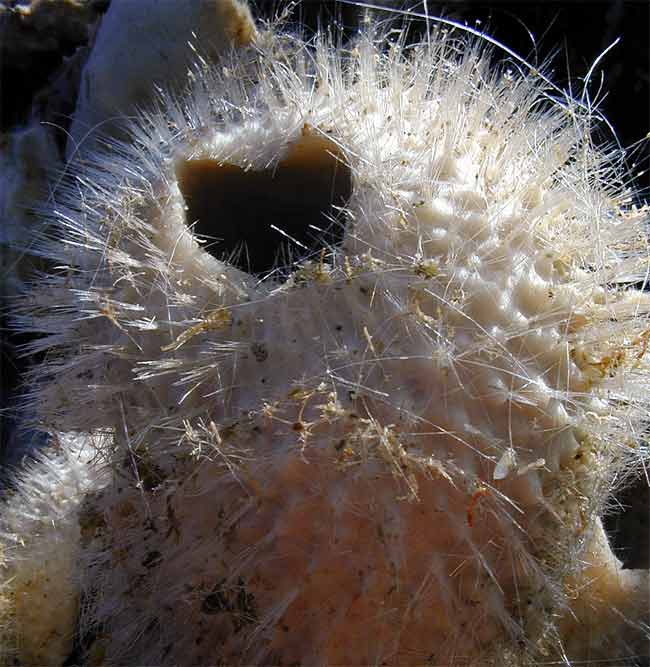Oldest Fossil Evidence for Animals Found

The oldest fossilized evidence of animals has been unearthed in Oman and reveals that tiny sea sponges were abundant 635 million years ago, long before most of the planet's other major animal groups evolved, according to a new analysis.
This early life hardly looked like us, but some of the so-called demosponges can be sizable today. Demosponges still make up 90 percent of all sponges on Earth and 100 percent of Earth's largest sponges, including barrel sponges, which can be larger than an old-style phone booth.
The ancient demosponges — probably measuring across no more than the width of a fork tine — were pinned down via fossilized steroids, called steranes, which are characteristic of the cell membranes of the sponges, rather than via direct fossils of the sponges themselves.
"The fact that we can detect sponge steranes at all suggests that by the Cryogenian Period [about 850 to 635 million years ago] demosponges were ecologically prominent and there were abundant demosponges living on the shallow sea floor," said geochemist Gordon D. Love of the University of California, Riverside, who headed up the analysis detailed in the Feb. 5 issue of the journal Nature.
Frosty times for simpler organisms
The Cryogenian is a geologic period dominated by glaciers and occurring prior to the Cambrian, when the fossil record shows a so-called explosion of most major groups of complex animals, including all the bilaterians (animals with a left and right side, unlike corals and sponges) — around 530 million years ago.
Prior to that, most organisms were simple. In fact, prior to the Cryogenian, the vast majority of marine organisms would have been single-celled bacteria and microalgae, some of which might have been multicellular as far back as 1.2 billion years ago, Love said.
Sign up for the Live Science daily newsletter now
Get the world’s most fascinating discoveries delivered straight to your inbox.
Fossils of microbe colonies currently are evidence of the first known life on Earth, dating back to 3.5 billion years ago. Thereafter came a long period with little major development.
The new analysis aside, fossils of the earliest multicellular organisms had been dated to 565 million to 543 million years ago. In recent years, some evidence pushed the date of the earliest animal fossil as far back as 575 million years.
A team of scientists at the American Museum of Natural History and Tierärztliche Hochschule Hannover in Germany recently stated that multicellular, amoeba-shaped animals called Placozoans are the closest living things to approximate Earth's original animal, based on a computer analysis of many genetic and morphological traits of numerous animals.
While Love's chemical fossils suggest that sponges were an early group of animals, it doesn't suggest they were necessarily the earliest ones.
More oxygen available
Love and his colleagues' discovery of the older chemical traces of sponges suggests that the shallow waters in some ocean basins in the Cryogenian Period contained enough dissolved oxygen to support simple multicellular organisms at least 100 million years before the Cambrian explosion. However, limits on that oxygen probably kept the demosponges small, he said.
Recently, scientists have started to think that the Cryogenian oceans were frozen to a depth of more than a mile, when so-called Snowball Earth conditions prevailed. Such frozen conditions would make it difficult for oxygen to move between the atmosphere and the seas.
Now that there is evidence of animals going back to 635 million years ago, it is worth asking if future research will find evidence of animal fossils going back even further. Love doubts the date will get much earlier than a glaciation event called the Sturtian, 720 million years ago, which caused big changes in ocean chemistry. So evidence might be found dating "perhaps as far back as 800 million years, but not much older than that," Love told LiveScience, "and I think an upper limit age of 750 million years that we present from dates in Oman may stand the test of time." Funding for the research came from Petroleum Development Oman, the NASA Exobiology Program, the National Science Foundation, the Agouron Institute and the NASA Astrobiology Institute. Much of the work was done at MIT, when Love was a post-doctoral research fellow there. His colleagues on the research included MIT professors Roger Summons and Samuel Bowrin.
- Evolution: Information and News
- Gallery: Rich Live Under the Sea
- Video – Life Rocks the Earth: Biologic and Mineral Evolution
Robin Lloyd was a senior editor at Space.com and Live Science from 2007 to 2009. She holds a B.A. degree in sociology from Smith College and a Ph.D. and M.A. degree in sociology from the University of California at Santa Barbara. She is currently a freelance science writer based in New York City and a contributing editor at Scientific American, as well as an adjunct professor at New York University's Science, Health and Environmental Reporting Program.










